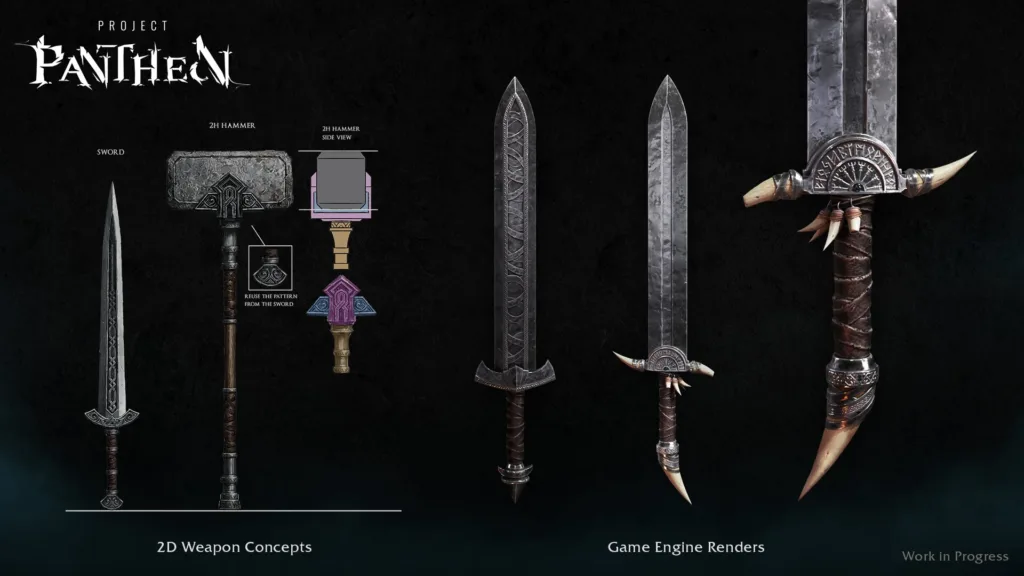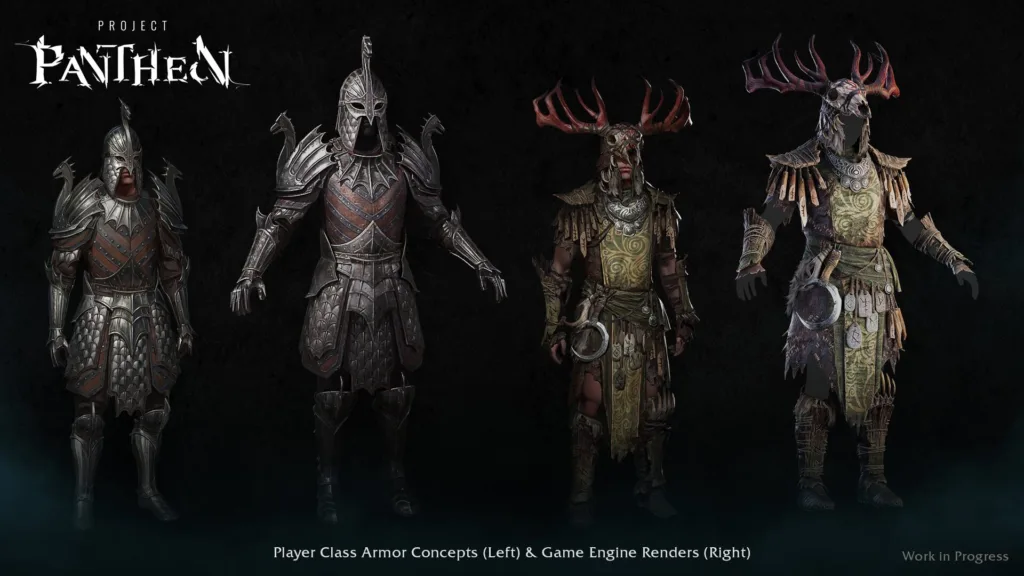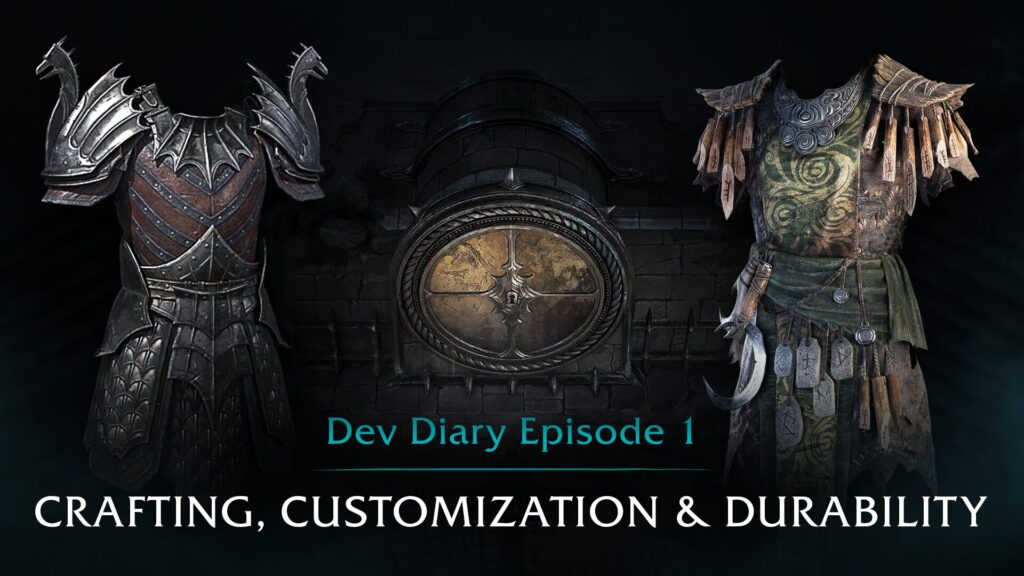March 21, 2025
Hello and welcome to our very first dev diary! I’m Andrei Chirculete, Game Director of Project Pantheon at Wolcen Studio. You may already know me as rEaPer from our Discord server. We recently gave you the choice to vote across all our official channels for the elements and features of Project Pantheon that you’re most interested in, and many of you wished to find out more about Crafting, Customization, and Durability!
These mechanics aren’t just systems layered onto the game—they are core to how you survive and progress. We want survival in Project Pantheon to not just depend on skill in combat. Preparation, adaptation, and resource management should matter just as much. Therefore, the crafting, customization, and durability of items will also shape how you approach battles and navigate the game’s player-driven economy. We intend for every decision—whether forging weapons, modifying abilities, or maintaining gear—to affect your journey through the afterlife.
Crafting: Forging the Tools of Survival
Crafting is central to progression in Project Pantheon. Every weapon, tool, and consumable must be created at specialized Crafting Stations. These stations are built and upgraded in the Sanctuary, each dedicated to a specific category—weapons, consumables, accessories, and more. This structure keeps crafting strategic, encouraging you to specialize rather than mass-produce everything at once.
Unlocking a station is only the beginning. Upgrades unlock stronger recipes and reduce crafting times for lower-tier items. The system rewards long-term investment. You will need to decide when to prioritize efficiency over immediate needs.
Resources fuel the crafting process. Materials come from harvesting, salvaging loot, and completing quests. But simply gathering materials isn’t enough. Extraction ties directly into crafting—every expedition is a chance to secure rare resources, but only if you survive and make it back. Crafting isn’t just about creating gear but weighing risk against reward.

Customization: Defining Your Playstyle
Customization in Project Pantheon is first and foremost about shaping the gameplay experience—it’s the way you modify your equipment that truly defines how you play. The system revolves around what we may call Gems, which allows you to modify and shape your weapons and equipment. Instead of offering fixed abilities, weapons come with slots, letting you choose which abilities to equip.
This means that even identical weapons can function in completely different ways. One sword might focus on raw damage, another on agility bonuses. Some players will optimize for power, others for speed or versatility. Experimentation is key. Right now, the system applies only to weapons, each functioning as a kind of “soft class.” While Project Pantheon uses a classless system, your gear effectively defines your role. Swapping weapons is like trying out a new class—without needing to start over or create a new character. We plan to expand this system to other gear types, deepening build variety and strategic options.
Cosmetic customization exists, but it’s separate from gameplay. Your character’s appearance can reflect your personal style, but your combat effectiveness depends entirely on what gear you choose and how you slot gems into it. Whether you rely on brute force, precision, or a tactical approach, your loadout is yours to shape.
Durability: The Economy of Survival
Nothing in Project Pantheon lasts forever. A newly forged sword might start at 100/100 durability, but each battle chips away at it. By the time you extract, it could be 80/100. Repairs can restore durability, but never fully. A once-pristine weapon will wear down over time, its maximum durability shrinking with each fix.
We know what you might be thinking—”Wait, my gear is going to break forever?” Not quite. Yes, durability limits how long an item lasts, however, with this mechanic we aim to create a meaningful loop where your gear matters. And this also includes your ability to maintain, replace, or rebuild it. You won’t have to repair your gear constantly, and you won’t lose your favorite weapon overnight.
This isn’t just a gameplay constraint—it’s a reflection of the world itself. The gods are gone. Reality is unraveling. Without divine order, Entropy spreads unchecked and eats at the very fabric of existence. Even Death, the being directing you to help restore balance under his guiding hand, can’t stop it entirely. Everything is falling apart, and your gear is no exception.
Decay isn’t an inconvenience—it drives the push-and-pull economy. Looting, crafting, and extracting new gear is less about improving your loadout and more about securing the resources to maintain your arsenal in a world consumed by entropy.

A Living, Breathing System
Crafting, customization, and durability aren’t isolated features. They are woven into the game’s economy and extraction loop. Every expedition is a chance to gather materials, improve gear, and refine your strategy. But nothing lasts forever. Every piece of equipment has an expiration date. Every ability is a choice that shapes your survival.
You see, success in Project Pantheon is less about what you find, and more about how you find it, and how you use it. Unlike traditional ARPGs, where the goal is often to chase a perfect item drop, our focus is on giving you consistent access to your ideal playstyle. It’s about building and maintaining the gear—through crafting, trading, and durability— that lets you thrive especially in the more competitive, high-stakes endgame.
Stay tuned for our next dev diary, where I will be sharing more information on the Dungeons in Project Pantheon!
Until then, the development team, including myself, is active on Discord, engaging with our players and listening closely to your feedback and questions. We’d love to have you be part of the conversation!

